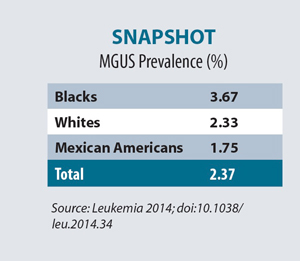MGUS Racial Disparities Highlighted
A first-of-its-kind study found that monoclonal gammopathy of undetermined significance (MGUS) is significantly more common in blacks than whites, and more often has features associated with higher risk of progression to multiple myeloma. The findings contribute to the current evidence involving MGUS and multiple myeloma. A racial disparity in the incidence of multiple myeloma has been evident, but whether it emanates from a higher prevalence of MGUS or from increased risk of progression from MGUS has been unclear.
Researchers at the National Cancer Institute, Centers for Disease Control and Prevention, and the Mayo Clinic in Rochester, Minn. conducted the analysis using stored serum samples from 12,482 individuals age 50 or older who participated in the National Health and Nutritional Examination Survey (NHANES) III or NHANES 1999–2004, of whom 2,331 were black. Previously, the largest population-based study of MGUS was from the almost exclusively Caucasian residents of Olmsted County, Minn.

The overall prevalence of MGUS was 2.4%, but the adjusted prevalence in blacks was 3.7%, compared with 2.3% in whites and 1.8% in Mexican Americans. Blacks’ higher MGUS prevalence escalated with age—8.6% of those older than age 80 had MGUS, nearly double that of similarly aged whites. In addition, blacks had higher M-protein levels than did whites or Hispanics, as well as a "strikingly lower" rate of IgM MGUS, which rarely progresses to multiple myeloma.
The researchers also found notable geographical variations in the prevalence of MGUS in the North and Midwest regions (3.1%) versus South and West regions (2.1%). These disparities beg further investigation to understand causative factors behind them. The authors investigated MGUS prevalence in relation to numerous risk factors, such as C-peptide levels, smoking status, C-reactive protein levels, and presence of rheumatoid arthritis, but with the exception of a trend toward increasing body mass index, none were significant.